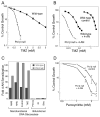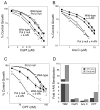Predicting enhanced cell killing through PARP inhibition
- PMID: 23193155
- PMCID: PMC3552016
- DOI: 10.1158/1541-7786.MCR-12-0512
Predicting enhanced cell killing through PARP inhibition
Abstract
PARP inhibitors show promise as combination and single agents in cancer chemotherapy. Here, we evaluate results obtained with mouse fibroblasts and the common laboratory PARP inhibitor 4-amino-1,8-naphthalimide (4-AN) and analyze the potential for enhanced cytotoxicity following the combination of a DNA-damaging agent and a PARP inhibitor. Methylated DNA bases are repaired by the monofunctional glycosylase-initiated single-nucleotide base excision repair (BER) pathway. An intermediate of this process has a single-nucleotide gap in double-stranded DNA containing the 5'-deoxyribose phosphate (dRP) group at one margin. This 5'-dRP group is removed by the lyase activity of pol β prior to gap filling; then completion of repair is by DNA ligation. PARP-1 binds to and is activated by the 5'-dRP group-containing intermediate, and poly(ADP-ribos)ylation is important for efficient repair. 4-AN-mediated sensitization to the methylating chemotherapeutic agent temozolomide is extreme, producing a level of cytotoxicity not seen with either agent alone. In contrast, with agents producing oxidative DNA damage repaired by bifunctional glycosylase-initiated BER, there is only weak sensitization by cotreatment with PARP inhibitor. Other clinically used DNA-damaging agents repaired by different DNA repair pathways also reveal minimal 4-AN-mediated sensitization. This information has potentially important implications for strategic use of PARP inhibitors in chemotherapy.
©2012 AACR.
Conflict of interest statement
Figures



Similar articles
-
Preventing oxidation of cellular XRCC1 affects PARP-mediated DNA damage responses.DNA Repair (Amst). 2013 Sep;12(9):774-85. doi: 10.1016/j.dnarep.2013.06.004. Epub 2013 Jul 18. DNA Repair (Amst). 2013. PMID: 23871146 Free PMC article.
-
Alkylation DNA damage in combination with PARP inhibition results in formation of S-phase-dependent double-strand breaks.DNA Repair (Amst). 2010 Aug 5;9(8):929-36. doi: 10.1016/j.dnarep.2010.05.007. Epub 2010 Jun 22. DNA Repair (Amst). 2010. PMID: 20573551 Free PMC article.
-
4-Amino-1,8-naphthalimide: a novel inhibitor of poly(ADP-ribose) polymerase and radiation sensitizer.Int J Radiat Biol. 1999 Jan;75(1):91-100. doi: 10.1080/095530099140843. Int J Radiat Biol. 1999. PMID: 9972795
-
Strategic Combination of DNA-Damaging Agent and PARP Inhibitor Results in Enhanced Cytotoxicity.Front Oncol. 2013 Sep 30;3:257. doi: 10.3389/fonc.2013.00257. Front Oncol. 2013. PMID: 24137565 Free PMC article. Review.
-
PARP inhibitors for cancer therapy.Expert Rev Mol Med. 2005 Mar 15;7(4):1-20. doi: 10.1017/S146239940500904X. Expert Rev Mol Med. 2005. PMID: 15836799 Review.
Cited by
-
Eukaryotic Base Excision Repair: New Approaches Shine Light on Mechanism.Annu Rev Biochem. 2019 Jun 20;88:137-162. doi: 10.1146/annurev-biochem-013118-111315. Annu Rev Biochem. 2019. PMID: 31220977 Free PMC article. Review.
-
XRCC1 counteracts poly(ADP ribose)polymerase (PARP) poisons, olaparib and talazoparib, and a clinical alkylating agent, temozolomide, by promoting the removal of trapped PARP1 from broken DNA.Genes Cells. 2022 May;27(5):331-344. doi: 10.1111/gtc.12929. Epub 2022 Mar 1. Genes Cells. 2022. PMID: 35194903 Free PMC article.
-
Size dependent anti-invasiveness of silver nanoparticles in lung cancer cells.RSC Adv. 2019 Jul 5;9(37):21134-21138. doi: 10.1039/c9ra03662h. eCollection 2019 Jul 5. RSC Adv. 2019. PMID: 35521328 Free PMC article.
-
Suicidal cross-linking of PARP-1 to AP site intermediates in cells undergoing base excision repair.Nucleic Acids Res. 2014 Jun;42(10):6337-51. doi: 10.1093/nar/gku288. Epub 2014 Apr 25. Nucleic Acids Res. 2014. PMID: 24771347 Free PMC article.
-
Inter-individual variation in DNA repair capacity: a need for multi-pathway functional assays to promote translational DNA repair research.DNA Repair (Amst). 2014 Jul;19:199-213. doi: 10.1016/j.dnarep.2014.03.009. Epub 2014 Apr 26. DNA Repair (Amst). 2014. PMID: 24780560 Free PMC article.
References
-
- Beard WA, Wilson SH. Structure and mechanism of DNA polymerase β. Chem Rev. 2006;106:361–82. - PubMed
-
- De Vos M, Schreiber V, Dantzer F. The diverse roles and clinical relevance of PARPs in DNA damage repair: Current state of the art. Biochem Pharmacol. 2012;84:137–46. - PubMed
-
- Lavrik OI, Prasad R, Sobol RW, Horton JK, Ackerman EJ, Wilson SH. Photoaffinity labeling of mouse fibroblast enzymes by a base excision repair intermediate. Evidence for the role of poly(ADP-ribose)polymerase-1 in DNA repair. J Biol Chem. 2001;276:25541–8. - PubMed
Publication types
MeSH terms
Substances
Grants and funding
LinkOut - more resources
Full Text Sources
Miscellaneous

